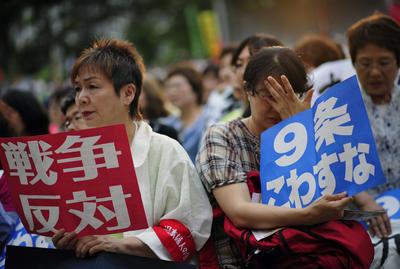to expand the operations of the Self Defense Forces (SDF). This will strengthen the US–Japan alliance, but could lead to a broadening of the use of the SDF, undermining Japan’s pacifist posture.
Alliances normally suppose that allies have mutual responsibility to defend each other. In the case of Japan, the current interpretation of the pacifist constitution only allows for ‘individual’ self-defence and limited armament. The Japanese government considers Japan’s participation in alliances to be constitutional, but not the military defence of its allies.
Recognition of Japan’s right to exercise collective self-defence would enable Japan to participate more widely and actively in US military operations. The Japanese government has previously considered recognising the exercise of collective self-defence in response to US requests in the 1990s and 2000s. For example, the 2000 Armitage–Nye report asked Japan to re-examine this constraint on alliance cooperation. Despite this, the Japanese public is wary of collective self-defence fearing that Japan will be entangled in foreign wars as well as regarding it as unconstitutional.
During Abe’s first term as prime minister (2006–2007) there was an attempt to lift the ban, but it failed as he suddenly resigned for health reasons. Abe and his Liberal Democratic Party secretary general Shigeru Ishiba are now attending to this unfinished business.
In the 1990s and early 2000s, recognising the exercise of collective self-defence would probably have provoked less complicated responses from Japan’s neighbours and allies. Japan was simply being asked to play a security role commensurate with its economic status. However, times have changed. The exercise of collective self-defence carries revisionist baggage in the present context as well as distrust that Abe is utilising it as a stepping stone toward Japan’s military normalisation, which further complicates regional relations.
There are three reasons for Abe’s activism on this issue.
First, Abe and Ishiba believe that the right to collective self-defence is a ‘deterrent mechanism’ against the challenge presented by China.
Second, they argue that Japan’s use of the right to collective self-defence will help to ensure US support vis-à-vis China over the Senkaku/Diaoyu islands. Ishiba asserts that the Japanese cannot ask young American soldiers to shed their blood, if the Japanese will not.
Both of these reasons raise the question of how far the scope of SDF operations should be broadened. As the challenge from China grows, Japan will need stronger deterrence. But its relative decline in relation to China will increase US costs in the defence of the Senkaku/Diaoyu islands. For this reason, Japan has to demonstrate a firmer commitment to the alliance, and in support of US military operations. But this will intensify tensions with China and domestic fears of entanglement in war.
Third, Abe and Ishiba want to remove Japan’s legal constraints on the SDF to allow for a wider range of political options in international disputes. Currently, Japan’s legal constraints on the SDF are too rigid to allow for practical operations, such as peacekeeping missions with the UN. Yet without the conventional pacifist constraints what mechanism will govern SDF operations?
Japan’s first National Security Strategy (NSS), which was released in December 2013, upholds Japan’s proactive contribution to peace, but it is unclear what ideas are behind it. In the NSS the primary national security objective is deterrence. However, in the 2014 East Asian Strategic Review, drafted by the National Institute for Defense Studies and published only in Japanese, it is misleadingly explained that Japan’s NSS is more liberal than its US and Australian counterparts.
It seems that Japan does not have a clear understanding of its new strategic direction or the pros and cons that collective self-defence entails. On the negative side, the exercise of the right to collective self-defence will change power relations in Northeast Asia whether Japan wants it to or not. Also, Sino–Japanese tensions will sharpen, and the emerging great power rivalry between the US and China be further complicated. On the positive side, the exercise of collective self-defence may give Japan greater autonomy by allowing it to expand its security role in the region as well court support beyond the US in order to balance against China.
Sadly, the Japanese public has not considered these issues and Japan is locked into a domestic debate about the constitutionality of the right to collective self-defence. Japan cannot remain mired in this debate. Deeper public debate is needed to understand how exercising the right to collective self-defence will be perceived throughout the Asia Pacific region and the broader ramifications this carries for Japan’s security and regional stability.
Toshiya Takahashi is a PhD Candidate at the National Security College, The Australian National University.

